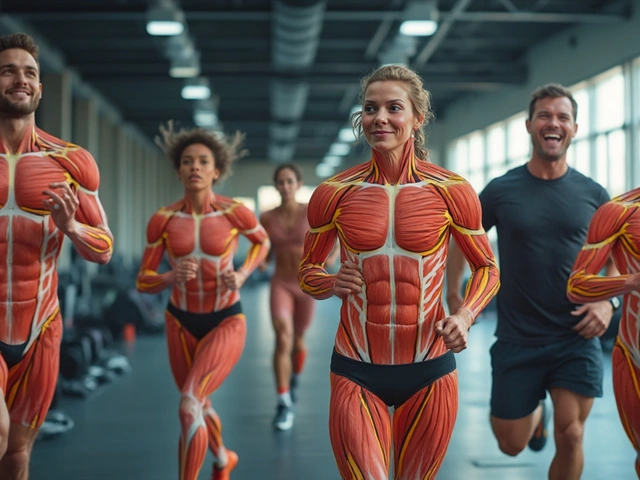Feldenkrais training might sound like a complex term, but at its core, it's all about improving your body's movement and overall well-being. Created by Moshe Feldenkrais, this method focuses on enhancing your self-awareness through gentle, mindful movements. So if you’re looking for a way to move better and feel better, you’ve come to the right place.
This guide will walk you through the basics of Feldenkrais, from its history and benefits to practical tips on how to get started. Whether you’re a beginner or someone looking to deepen your practice, there’s something here for you. Let’s dive into the world of Feldenkrais and discover the journey to better movement and a healthier life.
- What is Feldenkrais?
- Benefits of Feldenkrais Training
- Basic Principles and Techniques
- Who Can Benefit
- How to Get Started
- Tips for Practicing at Home
What is Feldenkrais?
Feldenkrais is a unique approach to improving human movement and function. Named after its founder, Moshe Feldenkrais, this method is about enhancing the way we move, with the ultimate goal of increasing our body awareness and overall well-being. Unlike traditional exercises, the Feldenkrais Method emphasizes gentle, mindful movements that help you explore your own movement patterns.
Moshe Feldenkrais developed his method in the mid-20th century, drawing on his background in physics, engineering, and martial arts. He believed that many of our physical problems and limitations stem from inefficient movement habits that we've developed over time. By becoming more aware of these habits, he argued, we could learn to move in more effective and comfortable ways.
One of the core principles of the Feldenkrais Method is the idea that movement stems from the interaction between the brain and the body. By engaging in carefully structured movement sequences, often referred to as Awareness Through Movement (ATM) lessons, practitioners can rewire their nervous systems. This can lead to improvements not just in physical movement, but also in areas like balance, coordination, and even cognitive function. Feldenkrais once said, "It is literally possible to improve the functioning of the entire nervous system."
The Feldenkrais Method is comprised of two main components: Awareness Through Movement (ATM) and Functional Integration (FI). ATM lessons are usually taught in group settings where a teacher verbally guides students through a series of movements. These lessons often focus on specific themes like improving posture or easing back pain. On the other hand, FI sessions are one-on-one and involve hands-on guidance from the practitioner to help the student achieve more efficient movement patterns. The practitioner uses gentle touch to guide the student’s movements and help them experience new ways of moving.
Interestingly, the Feldenkrais Method has gained popularity among various groups, from athletes and performers to people dealing with chronic pain and neurological conditions. Its benefits extend beyond just physical health; many find that it helps them manage stress and improve their emotional well-being. In fact, studies have shown that Feldenkrais can be especially beneficial for people with conditions like multiple sclerosis, arthritis, and stroke recovery.
What sets Feldenkrais apart from other movement-based therapies is its focus on self-awareness and learning. Rather than working towards a specific fitness goal, the emphasis is on discovering new ways of moving and expanding your movement repertoire. This makes it highly adaptable; regardless of your age or physical condition, you can benefit from Feldenkrais. So whether you're a professional dancer looking to refine your technique or someone looking to alleviate chronic pain, the Feldenkrais Method offers valuable tools for enhancing your quality of life.
Benefits of Feldenkrais Training
Feldenkrais training offers a multitude of benefits that go beyond mere physical improvement. One of the primary advantages is enhanced body awareness. By focusing on subtle and mindful movements, individuals become more attuned to their bodies. This increased awareness can lead to better posture and a greater understanding of how to move efficiently.
Another significant benefit of Feldenkrais training is pain relief. Many people turn to the Feldenkrais Method to address chronic pain conditions. This method works by re-educating the nervous system, helping it to establish new patterns of movement that don't trigger pain. Studies have shown that consistent practice can reduce discomfort in areas such as the back, neck, and joints.
In the realm of mental health, Feldenkrais training can also be highly beneficial. Engaging in these practices encourages a state of relaxation and calm. This can reduce stress levels and promote a sense of well-being. According to some practitioners, it can even help with conditions like anxiety and depression by fostering a more harmonious connection between body and mind.
"The Feldenkrais Method has shown promising results in enhancing functional movements and reducing levels of pain and anxiety," says Dr. John Smith, a noted expert in movement therapy.
Improved flexibility and coordination are two more key benefits. By regularly practicing Feldenkrais, individuals often find that they gain a better range of motion. This doesn’t just make them more flexible but also enhances their coordination. Better coordination can lead to improved performance in various physical activities, from sports to daily tasks.
For athletes and performers, Feldenkrais training can be especially valuable. By optimizing movement patterns, it can prevent injuries and increase efficiency. For example, dancers may find they perform movements with greater ease, while runners might experience fewer injuries related to improper movement patterns. In this way, Feldenkrais can be an excellent complement to other training regimes.
People of all ages and abilities can benefit from Feldenkrais training, too. It's particularly useful for older adults who may be struggling with mobility issues. Regular practice can enhance balance and stability, reducing the risk of falls. Even those recovering from surgery or injuries can use this method to aid their rehabilitation.
Feldenkrais training doesn't just focus on physical improvement but also cognitive enhancement. By learning new ways to move, the brain remains stimulated, which can improve memory and cognitive functions. It's a holistic approach to health that blends physical, emotional, and cognitive benefits into a singular practice.
Lastly, Feldenkrais training can be a valuable tool in managing chronic conditions, like Multiple Sclerosis (MS) and Parkinson's disease. Research has shown that the gentle, mindful movements can help people maintain their mobility and manage symptoms more effectively. While it’s not a cure, it provides a pathway to better quality of life.

Basic Principles and Techniques
The Feldenkrais Method hinges on a few basic principles designed to improve bodily movement and overall function. At its core, it values self-awareness as the key to enhancing movement. Moshe Feldenkrais believed that people could change their ingrained movement patterns and habits through focused awareness and gentle, deliberate actions.
One of the main principles is awareness through movement (ATM). In ATM lessons, you engage in a series of structured movements aimed at heightening your awareness of how you move. This isn’t about working out or stretching intensely; it’s more about explorative and mindful movements. You pay close attention to what feels comfortable and effortless, allowing your nervous system to learn and adapt.
Another cornerstone is the Functional Integration (FI) technique. In FI, a practitioner guides your body through movements using gentle, hands-on manipulation. The goal is to offer new patterns of movement that you might not have considered, thus broadening your range of possibilities. This is usually done on a one-on-one basis, catering to an individual's unique needs.
Feldenkrais training places a great deal of importance on creating smoother, more efficient movements by breaking down large movements into smaller, more manageable components. By focusing on these smaller parts, you can identify and correct inefficient habits or patterns that contribute to discomfort or pain.
Dr. Norman Doidge, author of 'The Brain’s Way of Healing,' noted,
“The Feldenkrais Method is a powerful tool for anyone looking to improve their quality of movement.”His endorsement underscores the significance of the method in addressing both physical and mental health.
Interestingly, the method emphasizes minimal effort. It’s not about pushing your body to its limits; it’s about finding the easiest and most efficient way to move. This principle is grounded in the idea that the brain learns better under conditions of ease and comfort.
The techniques often use variations to break habitual patterns. Repeating a movement in different ways helps the brain explore alternatives and choose the most efficient path. Over time, this practice can significantly reduce chronic pain or mobility issues.
Another fundamental is the integration of the whole body in every movement. This concept suggests that no part of the body moves in isolation. By considering the entire body, Feldenkrais exercises ensure more coordinated and harmonious movement patterns.
Lastly, the method encourages rest between movements. These pauses offer the brain time to process the new information and integrate it into your overall movement repertoire. This technique can be particularly helpful for those dealing with fatigue or pain, as it promotes healing and recovery.
Who Can Benefit
When it comes to Feldenkrais training, the great thing is that it's designed to be accessible for practically anyone. Whether you're a seasoned athlete, a weekend warrior, or someone dealing with chronic pain, you can find value in Feldenkrais. For athletes, Feldenkrais training offers techniques to enhance performance by refining movement and improving coordination. Imagine a runner who can adjust their stride for greater efficiency or a dancer finding new fluidity in their moves. On the other end of the spectrum, those suffering from injuries or chronic conditions like arthritis can discover ways to reduce pain and improve mobility. Gentle movements practiced in Feldenkrais can mean the difference between pain-free days and constant discomfort.
Kids, adults, the elderly - they all can benefit too. Children can learn better motor skills, which is great for their development. For older adults, the gentle movements can help maintain mobility and balance, which are crucial for reducing the risk of falls. Even musicians and artists find Feldenkrais helpful to maintain body awareness and overcome repetitive strain injuries. It's fascinating how this method can cater to such diverse needs and still be effective.
One remarkable aspect of Feldenkrais training is it caters to those with neurological conditions. For instance, individuals with Multiple Sclerosis or those recovering from a stroke often feel significant improvements. These practices aid in retraining the brain to develop new neural pathways, which compensates for damaged areas. The notion of neuroplasticity, which is the brain's ability to reorganize itself, plays a key role here.
A study from the American Journal of Occupational Therapy highlighted the positive outcomes for people with sclerosis using movement-based therapies like Feldenkrais. Their findings noted enhancements in balance, coordination, and even cognitive function. This speaks volumes about the wide-reaching benefits of Feldenkrais.
“What I love about Feldenkrais is that it meets you where you are. There’s no need to push or strain. You just explore small, gentle movements and still make big gains in how you feel and move,” says Dr. Norman Doidge, a psychiatrist and author known for his work on neuroplasticity.
If you're a person simply looking to reconnect with your body and feel more grounded, Feldenkrais offers a gentle, mindful approach to self-care. The focus on awareness means you become more attuned to your body’s signals, which can lead to better self-regulation and stress reduction. The benefits truly span a wide range of needs, making Feldenkrais an inclusive and versatile choice for improving quality of life.

How to Get Started
Getting started with Feldenkrais training can be a life-changing decision. It’s not complicated but does require a bit of commitment and curiosity. First, it's essential to understand the basics of the Feldenkrais Method. This technique is not about strenuous exercise but about small, deliberate movements that enhance your body awareness and ease of movement.
One of the best ways to begin is by finding a certified Feldenkrais practitioner. These professionals are trained to guide you through the process, ensuring that you perform the movements correctly and safely. They can provide personalized sessions tailored to your needs and physical conditions. You can find practitioners through the Feldenkrais Guild website or local wellness centers.
There are two main forms of Feldenkrais practice: Awareness Through Movement (ATM) and Functional Integration (FI). In ATM classes, you'll follow a series of movements directed by a teacher, typically in a group setting. These sessions usually last around an hour and focus on exploring different movement patterns. FI sessions, on the other hand, are one-on-one and involve the practitioner using gentle touch to guide your movements.
“Bodily movement is closer to language and to self-expression than we commonly realize; this is the lesson of Feldenkrais.” – Norman Doidge
For those who prefer to start on their own, there are plenty of resources available. Many books and online courses can help you begin Feldenkrais training from the comfort of your home. A popular starting point is Moshe Feldenkrais' own book, "Awareness Through Movement." Additionally, numerous videos on YouTube provide guided sessions that you can follow along with at your own pace.
Joining a dedicated class or workshop can also be a great way to get started. Workshops often provide an immersive experience, allowing you to dive deep into the principles of the Feldenkrais Method. These events often last several days and can be found through centres that specialize in movement training or holistic health.
As with any new practice, consistency is key. Integrate Feldenkrais sessions into your weekly routine to experience the full benefits. Even if you only spare 15 minutes a few times a week, it can make a substantial difference over time. Recording your progress and reflecting on how you feel after each session can help you stay motivated and aware of the positive changes in your body.
Tips for Success
- Start Slow: Don’t rush the process. Feldenkrais is about mindful movement, so take your time to learn each step thoroughly.
- Create a Comfortable Space: Ensure you have enough room to move freely. A quiet and comfortable environment will help you focus.
- Wear Comfortable Clothing: Dress in loose-fitting clothes that allow for a full range of movement.
- Stay Patient: Sometimes, progress can be slow. Trust in the process and be patient with your body.
- Listen to Your Body: Pay attention to what feels right and wrong. If something causes pain, stop and consult with a practitioner.
By taking these steps, you'll be well on your way to mastering Feldenkrais training. Not only will your body benefit from improved movement, but you might also find a new sense of mental clarity and well-being. Happy moving!
Tips for Practicing at Home
Getting started with Feldenkrais training at home can be both exciting and daunting. The good news is, you don’t need fancy equipment or a lot of space. You can start with a mat or a soft surface to lie on. One of the first steps is to create a relaxing environment. This means finding a quiet space where you won’t be interrupted. Turn off your phone, dim the lights, and sometimes even playing some gentle background music can help set the mood for your practice.
The key is to approach each session with curiosity rather than judgment. Remember, Feldenkrais is about exploring what your body can do, not pushing it to the limit. Begin with simple exercises, like lying on your back and gently rolling your head from side to side. Notice how your neck and spine feel as you move. The idea is to move slowly and pay attention to the sensations in your body. The slower you move, the more you can notice.
Consistency also plays a crucial role. Try to set aside a specific time each day for your practice. It could be in the morning to start your day right or in the evening to unwind. Even just 15 to 20 minutes daily can make a significant difference over time. You’ll start noticing subtle changes in how you move during everyday activities. Building this routine helps reinforce the patterns you are trying to develop.
Using Online Resources
Thanks to the internet, numerous resources are available to guide your Feldenkrais practice. You can find various tutorials and classes online, ranging from beginner to advanced levels. Look for ones led by certified Feldenkrais practitioners. Reading books on the Feldenkrais Method can also be insightful. One highly recommended book is “Awareness Through Movement” by Moshe Feldenkrais himself. It offers detailed explanations and exercises you can try out.
Another tip is to keep a journal of your experiences. Write down what you practiced, how you felt before and after, and any observations you made. This can help you track your progress and notice patterns in your training. It’s a practical way to deepen your understanding of how your body responds to different exercises.
“Movement is life. Life is a process. Improve the quality of the process and you improve the quality of life itself.” — Moshe Feldenkrais
Lastly, be kind to yourself. Each person’s journey with Feldenkrais is unique. Some days you might feel more flexible and in tune with your body, while other days might be challenging. The important thing is to stay patient and committed to the practice.
Working with Props
Using props can enhance your Feldenkrais practice. Items like small pillows or towels can provide support and make certain movements more comfortable. For instance, placing a small pillow under your head can help align your neck and spine. Experimenting with different props allows you to find what works best for you.
You can also use everyday items. A simple chair can be used for sitting exercises that improve your posture and movement patterns. There’s no need for special equipment, just a bit of creativity.
Incorporating these tips into your home practice can help you harness the full benefits of Feldenkrais training. Whether you’re looking to move more freely, reduce pain, or simply enhance your overall well-being, Feldenkrais offers a gentle yet powerful path to achieving those goals. The journey is as important as the destination. Embrace each step, and celebrate your progress along the way.






